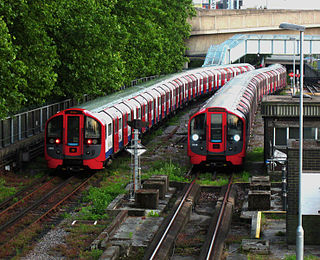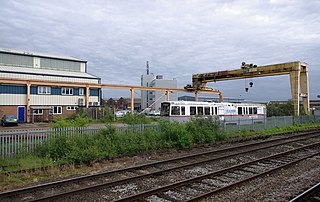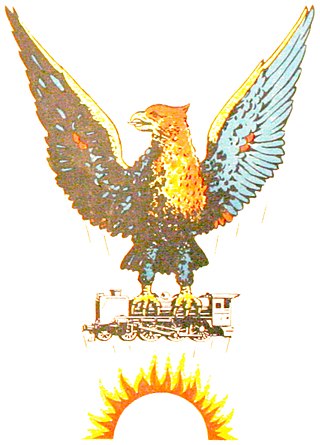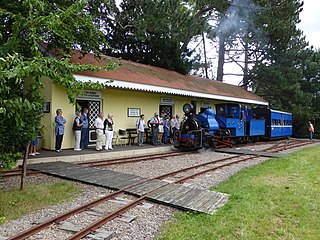

This is a partial list of products manufactured by the Gloucester Railway Carriage and Wagon Company:


This is a partial list of products manufactured by the Gloucester Railway Carriage and Wagon Company:

A railroad car, railcar, railway wagon, railway carriage, railway truck, railwagon, railcarriage or railtruck, also called a train car, train wagon, train carriage or train truck, is a vehicle used for the carrying of cargo or passengers on a rail transport network. Such cars, when coupled together and hauled by one or more locomotives, form a train. Alternatively, some passenger cars are self-propelled in which case they may be either single railcars or make up multiple units.

Metro-Cammell, formally the Metropolitan Cammell Carriage and Wagon Company (MCCW), was an English manufacturer of railway carriages, locomotives and railway wagons, based in Saltley, and subsequently Washwood Heath, in Birmingham. The company was purchased by GEC Alsthom in May 1989; the Washwood Heath factory closed in 2005 and was demolished in early 2019.

The Birmingham Railway Carriage and Wagon Company (BRC&W) was a railway locomotive and carriage builder, founded in Birmingham, England and, for most of its existence, located at nearby Smethwick, with the factory divided by the boundary between the two places. The company was established in 1854.

London Underground rolling stock includes the electric multiple-unit trains used on the London Underground. These come in two sizes, smaller deep-level tube trains and larger sub-surface trains of a similar size to those on British main lines, both running on standard gauge tracks. New trains are designed for the maximum number of standing passengers and for speed of access to the cars.

The Standard Stock title was applied to a variety of Tube stock built between 1923 and 1934, all of which shared the same basic characteristics, but with some detailed differences. This design is sometimes referred to as 1923 Tube Stock, 1923 Stock, or Pre 1938 Stock. Most of the Standard Stock was built to replace the first generation of "Gate Stock" Tube trains or to provide additional trains for extensions built in the 1920s and early 1930s. Standard Stock cars consisted of motor cars, with a driver's cab, behind which was a "switch compartment" occupying approximately one-third of the length of the car, plus trailer cars and "control trailers", with a driving cab but no motor. All were equipped with air operated sliding doors. The guard's door on the earlier trains was a manually operated, inward-opening hinged door.

The London Underground 1962 Stock was a type of London Underground tube train built for use on the Central line. They were used on the Central line between 1962 and 1995, with some later being transferred to the Northern line where they were used until 1999.

Gloucester Railway Carriage and Wagon Company (GRC&W) was a railway rolling stock manufacturer based in Gloucester, England from 1860 until 1986. Products included goods wagons, passenger coaches, diesel multiple units, electric multiple units and various special-purpose vehicles. The company supplied the original fleet of red trains for the Toronto Subway, which were based upon similar vehicles to the London Underground. The company also produced pivoting sections for the Mulberry Harbour for the British War Office 1944.

The Victorian Railways (VR), trading from 1974 as VicRail, was the state-owned operator of most rail transport in the Australian state of Victoria from 1859 to 1983. The first railways in Victoria were private companies, but when these companies failed or defaulted, the Victorian Railways was established to take over their operations. Most of the lines operated by the Victorian Railways were of 5 ft 3 in. However, the railways also operated up to five 2 ft 6 in narrow gauge lines between 1898 and 1962, and a 4 ft 8+1⁄2 instandard gauge line between Albury and Melbourne from 1961.

Derby Litchurch Lane Works, formerly Derby Carriage and Wagon Works, is a railway rolling stock factory in Derby, England. It is presently owned by the multinational transportation manufacturer Alstom.

A mixed train or mixed consist is a train that contains both passenger and freight cars or wagons. Although common in the early days of railways, by the 20th century they were largely confined to branch lines with little traffic. Typically, service was slower, because mixed trains usually involved the shunting (switching) of rolling stock at stops along the way. However, some earlier passenger expresses, which also hauled time-sensitive freight in covered goods wagons (boxcars), would now be termed mixed trains. Generally, toward the end of the mixed train era, shunting at intermediate stops had significantly diminished. Most railway passenger and freight services are now administered separately.

Operation Phoenix was a post-World War II rehabilitation program carried out by the Victorian Railways (VR) in Australia. The program commenced in 1950 and was originally planned to take 10 years and cost £80 million pounds. Operation Phoenix was named after the bird from Egyptian mythology.

Goods wagons or freight wagons, also known as goods carriages, goods trucks, freight carriages or freight trucks, are unpowered railway vehicles that are used for the transportation of cargo. A variety of wagon types are in use to handle different types of goods, but all goods wagons in a regional network typically have standardized couplers and other fittings, such as hoses for air brakes, allowing different wagon types to be assembled into trains. For tracking and identification purposes, goods wagons are generally assigned a unique identifier, typically a UIC wagon number, or in North America, a company reporting mark plus a company specific serial number.
The Victorian Railways used a variety of railway wagons for the transport of livestock.
The Kent & East Sussex Railway has hosted a variety of heritage rolling stock since the line was closed by British Railways in 1961.
The Great Central Railway (Nottingham) (formerly known as the Nottingham Heritage Railway) is a heritage railway located at the Nottingham Transport Heritage Centre (NTHC), on the south side of the village of Ruddington, in Nottinghamshire. The route consists of almost 10 miles (16 km) of the former Great Central Main Line from Loughborough South Junction (with the Midland Main Line) to Fifty Steps Bridge and the site of Ruddington's former GCR station, plus a branch line from Fifty Steps Bridge to Ruddington Fields station which is located on a former Ministry of Defence site next to Rushcliffe Country Park.
The Victorian Railways used a variety of boxcars or covered goods wagons for the transport of all manner of goods. This page covers the history and development of the various classes, and how they changed through their lives.

The Beeches Light Railway was a private narrow gauge railway in Steeple Aston, Oxfordshire, England, in the garden of the late Adrian Shooter, the former director of Chiltern Railways. The line contained one station, Rinkingpong Road at an elevation of 351 feet (107 m) above sea level.

Presflo and Prestwin were the designation for two types of goods wagon designed by British Railways in the 1950s for the carriage of powdered goods. The Presflo design was specifically for carriage of powdered cement but wagons to this design were subsequently used to transport other powdered commodities. The later Prestwin wagons were designed to overcome problems encountered with using the Presflo design for certain powdered commodities. Both types of wagon were loaded by gravity but unloaded using compressed air.